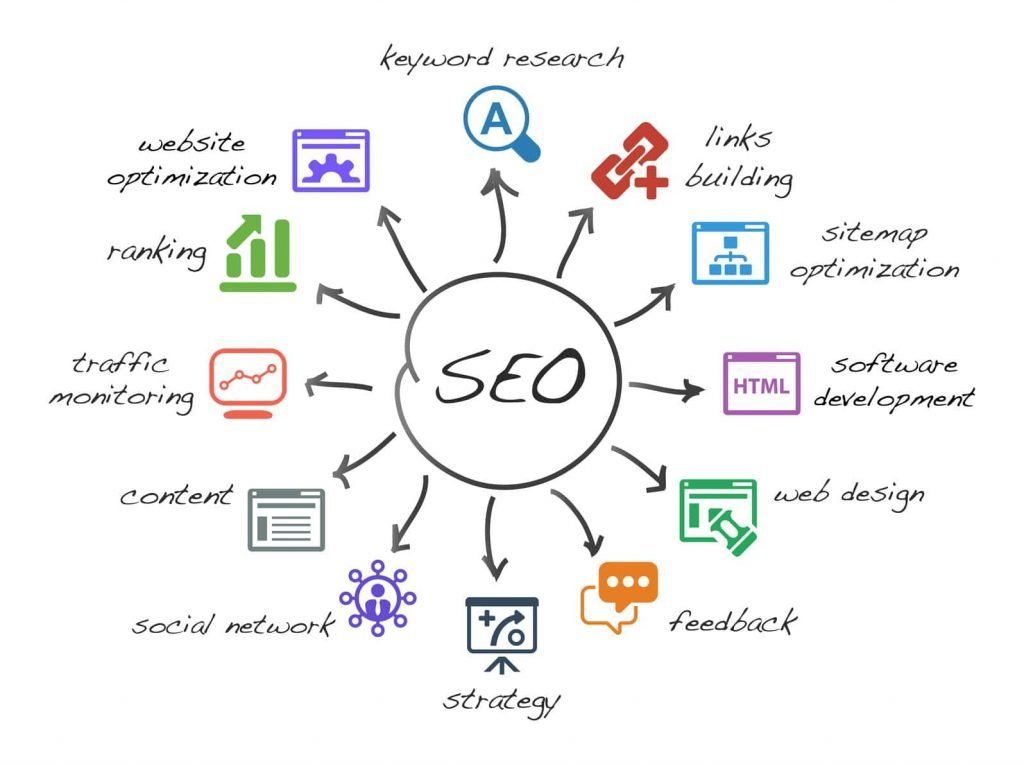You’ve likely encountered the acronym SEO, especially if you’ve dabbled in the world of digital marketing or operate an online business. However, you might be astonished at how many people recognize the term but lack a comprehensive understanding of its implications. Whether you’re a newcomer to SEO or just need a refresher, you’ve come to the right place.
In this in-depth guide, we at OBCIDO Inc. aim to elucidate all the critical aspects of a robust SEO (Search Engine Optimization) game plan, covering:
– The significance of SEO and why it remains indispensable
– The foundational elements of SEO, including keywords, metadata, and link-building
– Eight targeted methods based on the latest SEO trends to set your website on the path to success

Why is SEO Pivotal?
As per industry insights, a striking 61% of marketers regard SEO as the cornerstone of online prosperity, compelling contemporary businesses to allocate around 41% of their marketing budget to it. To put it succinctly, an effectively outlined SEO blueprint can not only amplify your web traffic but revolutionize your entire business landscape.
In our current digital age, characterized by increased online activities—from shopping to video streaming and endless virtual meetings—the role of SEO has become indispensable for numerous entities. As we look forward to another year, how can you adjust your SEO approaches to be more attuned to the evolving digital atmosphere? Let’s begin by unpacking the essentials.

The Cornerstones of Any SEO Strategy
At its core, SEO is the art and science of optimizing your website through quality content and technical enhancements to increase visibility on Search Engine Results Pages (SERPs). Quantity also plays a pivotal role. Producing more content, incorporating more links, and utilizing a broader range of keywords can help you ascend the rankings over time. This process of gradual improvement is known as ‘scaling’.
- Keyword Targeting
Keywords are the phrases frequently queried in search engines like Google and Bing. Their proper utilization is integral to improving your website’s rankings. While keyword strategies have evolved, current best practices involve thorough research, diversification, and organic inclusion in your content.
- Metadata
Think of metadata as your online storefront. Meta titles and descriptions act as the initial point of contact with users on SERPs. Also, search engines deploy ‘crawlers’—imagine minuscule digital scouts—that comb through your website, using metadata to quickly comprehend your site’s relevance.
- Backlinks
Shifting towards the technical dimensions, securing backlinks is another fundamental element in optimizing SEO performance. These are links from other websites that direct traffic back to yours, thereby enhancing your domain authority and the likelihood of garnering additional clicks.
- Technical SEO
From ensuring swift site loading speeds to removing ‘toxic’ backlinks and designing a clear XML sitemap, addressing these backend issues can markedly elevate your overall SEO performance. Given that over half of all web traffic is mobile-based, aspects like user experience (UX) are more critical than ever.
- SEO Metrics
A nuanced understanding of SEO metrics is indispensable for tracking, scrutinizing, and refining your strategy.
Why Go Organic?
If long-term viability and cost-efficiency are your primary digital marketing objectives, organic SEO-driven approaches reign supreme. Unlike paid advertising, SEO offers enduring benefits and a more stable cost structure. While SEO can initially feel like a slow climb, perseverance yields compounded advantages, including elevated traffic and better rankings.

By targeting ‘long-tail’ keywords and diving deep into specific subtopics, even small to medium-sized businesses can quickly realize tangible results. Such keywords account for over a third of all queries on Google, offering not only less competition but also ample opportunities for driving organic traffic.
Success in the world of SEO isn’t solely about chasing the most sought-after keywords. It’s fundamentally about understanding your audience and delivering what they’re actively searching for. OBCIDO offers these eight enduring SEO strategies to build an effective and human-centered approach to search engine optimization.
- Prioritize Content for Your Audience, Then Optimize for Search Engines
In tune with the ever-evolving Google algorithm, OBCIDO emphasizes that a successful SEO strategy puts human readers first. Crafting content that resonates with your target audience is non-negotiable. Forced keyword inclusion or unnatural stuffing will stick out like a sore thumb. Keywords should naturally complement and elevate your content, never disrupt it.
- Strategically Deploy Keywords
Although user intent should guide your SEO efforts, OBCIDO underscores the critical role of keywords. Your SEO journey begins with meticulous keyword research. Utilize tools like Google Ads and Ahrefs to pinpoint your seed keywords, and delve deeper to discover long-tail variations. Also, pay attention to metadata and anchor texts when incorporating these keywords. Maintain a balanced approach; excessive keyword stuffing harms more than it helps.

- Zero in on User Experience (UX)
Nothing repels a user faster than a clunky website. OBCIDO insists that UX is pivotal for both user satisfaction and SEO performance. Neat site architecture, mobile optimization, and user-friendly layouts facilitate better crawlability for Google bots, thus positively affecting your search rankings. With Core Web Vitals now influencing rankings, focusing on page speed has become indispensable.
- Develop a Robust Link-Building Strategy
Links serve as pathways for both users and search engine crawlers. According to OBCIDO, a well-crafted link-building plan can begin showing results within one to three months. Both internal and external links matter. While outbound links enhance the value of your content, internal links help bots understand your site’s structure.
- Craft Content for Featured Snippets
Featured snippets have become a SERP staple, offering prime real estate for your content. OBCIDO suggests using specific formatting elements like bullet points, numbered lists, and direct question-answer formats to increase your odds of landing in this coveted spot. While snippets may not always guarantee clicks, they do amplify brand visibility.
- Eliminate Elements That Hinder Site Speed
Slow-loading pages are a no-go in today’s instant-gratification era. OBCIDO advises that one of the easiest ways to boost both UX and SEO is to streamline your site. Actions like removing outdated plugins, compressing images, and optimizing code can do wonders for your loading time. Regularly use tools like Google Page Speed Insights or GTmetrix to keep tabs on your site’s performance.
- Stay Updated on Google Algorithm Changes
The SEO landscape is in constant flux, largely due to frequent updates to Google’s algorithm. OBCIDO recommends staying abreast of these changes by subscribing to industry news and participating in SEO forums. Monitoring your site metrics via Google Analytics or SEMrush can also provide insights into how algorithm updates may have impacted your rankings.
- Continuously Update and Expand Your Content
SEO is an ongoing endeavor, as pointed out by OBCIDO. Revamping old content to include updated keywords or improved readability can significantly boost your traffic. Conducting a comprehensive content audit with tools like SEMrush and Yoast can reveal gaps and opportunities. Turn high-performing pages into cornerstone articles, continually updating and linking to keep the momentum going.
By implementing these eight strategies championed by OBCIDO, you’re not just optimizing for search engines; you’re building a resource that genuinely serves your audience’s needs.





